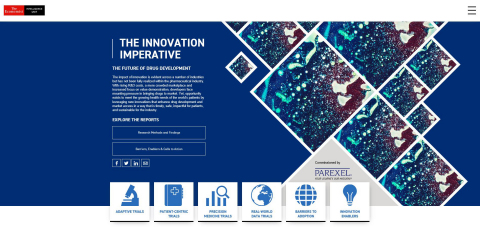BOSTON--(BUSINESS WIRE)--A new report released today by the Economist Intelligence Unit (EIU) and commissioned by PAREXEL International Corporation reveals that new innovations in drug development have a positive impact on clinical trial timelines, likelihood of market launch, and inclusion on selected payer formularies. The research program evaluated adaptive, patient-centric, precision and real-world data trials and found that the innovations had a consistently positive impact on these critical success factors for the industry, yet demonstrated low adoption rates.
“Drug development has become increasingly complex and more expensive over time. In an industry where failure rate can be as high as 90 percent and the average time to market for a drug has hovered around 12 years for the past three decades, the need to innovate is paramount,” said David Humphreys, Head of Health Policy for the EIU and lead author on the research report. “With this research, we aimed to quantify, for the first time, how the industry can use innovations in drug development and market access to improve efficiency, rekindle productivity and restore sustainability.”
The Innovation Imperative: The Future of Drug Development is the result of a research program conducted by the EIU to identify the most effective innovations in drug development and market access and analyze their impact against key industry success criteria using clinical trial data and other sources in the United States, the European Union, China and Japan. Most notably, likelihood of launch was 13 percent higher for drugs developed using adaptive trials, 19 percent higher for patient-centric trials, 10 percent higher for precision medicine trials and 21 percent higher for trials using real-world data. The research also showed that drugs in key therapeutic areas – neurology, oncology and rare diseases – that were developed with these innovations were more likely to reach market launch, with chances increasing by 16 percent on average in these therapeutic areas. The impact of the innovations was largest in oncology, where innovation drugs had a 33 percent higher likelihood of launch.
Trial efficiency also demonstrated improvement through the adoption of innovations, with patient recruitment time reduced by at least 37 percent for the therapeutic areas studied. The EIU also evaluated eight major payer formularies and found that drugs that were approved in 2015-17 and developed using one or more of the selected innovations were more likely to have achieved formulary inclusion by 2018.
Conversely, the research indicates a low utilization of these innovations, driven by a combination of systemic and cultural hurdles. Despite the quantifiable positive impact of the selected innovations, utilization is low across Phase II and III trials – ranging from less than 1 percent for adaptive designs and real-world data trials respectively, to 5 percent for patient-centric and 14 percent for precision medicine trials. The research aims to identify how the relevant stakeholders can evolve the current model to support drug development innovations. Enablers include the use of advanced data and analytics, workforce readiness initiatives, collaborative partnerships among diverse stakeholders, and early regulator, payer and patient engagement.
“The most striking finding was that the adoption rates for these four innovations – all of which can have a measurable impact on trial efficiency, likelihood of launch and inclusion in formularies – were surprisingly low,” said Alberto Grignolo, Ph.D., Corporate Vice President, PAREXEL. “The research demonstrated various barriers to adoption, including silos that have traditionally divided competitors, payers, patients and regulators. This is a call to action for the industry and other stakeholders to collaborate now and find creative ways to adapt our organizations, behaviors and systems to foster a more fertile environment for innovation.”
To download the full report, please visit https://druginnovation.eiu.com.
About the Economist Intelligence Unit
The Economist Intelligence Unit (EIU) is the research and analysis division of The Economist Group and a world leader in global business intelligence. The EIU has nearly 70 years’ experience in helping businesses, financial firms and governments to understand how the world is changing and how that creates opportunities to be seized and risks to be managed.
About PAREXEL International
PAREXEL International Corporation is the world’s leading innovator of biopharmaceutical services. We simplify our clients’ journey of transforming scientific discoveries into new medical treatments for patients with high-quality Phase I-IV clinical research, regulatory, consulting and market access services. PAREXEL develops breakthrough innovations and solutions by leveraging its comprehensive therapeutic, technical and functional expertise in more than 100 countries around the world. For more information visit www.PAREXEL.com.
PAREXEL is a registered trademark of PAREXEL International Corporation. All other trademarks are the property of their respective owners.




